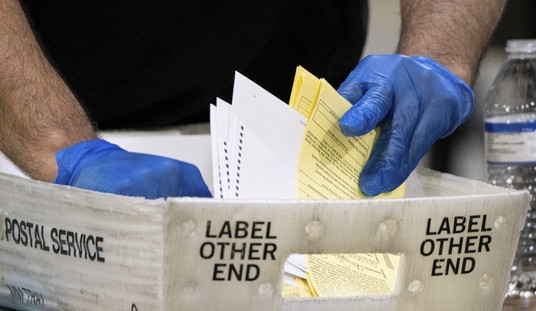Matt Labash of the Weekly Standard has a great piece of reporting on Ward Churchill’s visit to San Francisco.
Here’s a lengthy excerpt:
Churchill takes the dais, uncoiling his long frame like a python warming itself in the sun, and lets his pearl-buttoned denim shirt drop to the floor, giving it an angry kick. He’s wearing a stained T-shirt. In an over-pronounced Indian cadence (what Indian activist and longtime Churchill nemesis Suzan Harjo calls his “Tonto talk”), he brings greetings from the elders of the Keetoowah band of Cherokee, and uncorks his customary tribute to Leonard Peltier, still rotting in a cage on false charges.
He tells the people that he hasn’t come to speak “truth to power,” since “power never listens. Power knows everything I’m going to say better than I do.” Instead, he’s speaking “truth to people in the teeth of power, and that’s the only truth I know.” At this point, Churchill could be enjoying the love-bombing he gets from the expectant audience. But instead, he’d rather throw a fragmentation grenade. “Charlie Brennan, are you here?” he asks in his low, tomcat growl.
Brennan is a Rocky Mountain News scribe who has done some of the most exhaustive reporting on the Churchill saga, even unearthing ex-wives who’ve called Churchill a bullying control freak and worse. Brennan is in the audience, and the room turns to see him scribbling away furiously without looking up. “Yeah, Hi Charlie!” bellows Churchill. “Having a nice day now? My turn. I got the high ground. . . . Are you still beating your wife, Charlie? Answer me yes or no, please. And remember, I got nine people who hate your guts and are going to comment on whatever it is you have to say.” After demanding to see proof that Brennan is white (he’d probably never felt whiter), Churchill pushes the assault: “And you purport to be a man, . . . yet only one of your parents was, and you know it! . . . I’m practicing the journalist trade. . . . I expect a job at the Rocky Mountain News when I get back.”
The crowd might’ve yelled “Off with his head!” but it was hard to tell since they were speaking in tongues. And this was all before Churchill got to the Eichmann charge, which had been grossly misinterpreted the first time around. Of the World Trade Center victims, Churchill needs to make one thing clear. “I didn’t actually say they were Eichmann, I said they were little Eichmanns.” By that, he means that like Eichmann, who didn’t directly kill anyone, and who was merely following orders by overseeing Jewish transport operations and other logistical concerns, they were good Germans, “the technocrats of empire,” who participated, perhaps even unwittingly, in the immiseration of countless cultures.
Forget the sloppy historical analogy, since even if you favor a heads-up comparison between modern-day America and Nazi Germany, Eichmann was a bit more proactive than Churchill allows, recounting in his own words how he witnessed a mother shot with a baby in her arms, “his brains splattered all around, also over my leather overcoat. My driver helped me remove them.”
Forget, also, that if you page through the obituaries of Cantor Fitzgerald financiers–that company being Churchill’s oft-cited embodiment of American complicity and callousness–you discover all sorts of examples that complicate Churchill’s line: There were people like Juan Cisneros, who volunteered as a Big Brother, and who only wanted to be a bond trader until he could sock away enough money for his parents, who’d immigrated from Guatemala. Or like Matthew Leonard, Cantor’s director of litigation, who helped the homeless and did extensive pro bono work for poor people in Chinatown. Such lives couldn’t possibly be as noble as getting paid out of the same compulsory-taxes kitty that finances our unjust wars, or cataloguing the stereotypes in Dances with Wolves, or collecting five grand a throw to feed discontent to roomfuls of emaciated anarchists, when what they most need is a hot shower and a cheeseburger.
What Churchill is really trying to say is that from Wounded Knee to the Tokyo Firebombing to our sanctions starving half a million children in Iraq (his favorite talking point), we are guilty of an “uninterrupted stream of massacres.” Saddam Hussein–who cared about Iraqi children enough to tie them to tanks as human shields, who skimmed $20 billion from the Oil-for-Food program after it was implemented in 1996, and who before that turned down deal after deal for humanitarian aid if it came with monitoring conditions to ensure it was being used for food (all while finding the scratch to build 48 palaces)–doesn’t figure in Churchill’s narrative.
I spend another hour or so watching Churchill stoke the fire, telling the assembled that they should get serious: “Untangle your head from the jewelry, fill in the holes with body putty, put on some straight looking clothes so they can’t see who you are. Get inside. Bring your weapon to bear.” He then walks it back from being an endorsement of violence: “Oh my God, he’s advocating people turning themselves into suicide bombers! No, I don’t think suicide is the constructive approach. . . . Maybe it’s your ideas, maybe you can convince people.”
But violence is certainly something he hasn’t foresworn in books like Pacifism as Pathology (1998), which argues that sit-ins and Smokeouts just aren’t cutting much ice. Leading by example is Ed Mead, who wrote the book’s introduction, and who spent 18 years in prison as a member of the George Jackson Brigade, which bombed, among other things, three different government buildings in the 1970s. Churchill claims in the book that he once taught a hands-on workshop entitled “Demystification of the Assault Rifle” (a group of lesbian feminists showed up and denounced it as “macho swaggering”). And he admits to me, “I have more guns than the average liberal and less than Charlton Heston,” and, “yes, I’ve participated in armed struggle,” since the “right to engage in the use of armed force to counter the forcible usurpation of rights . . . is rather prominently enshrined in both domestic and international law.”
On a later occasion, I press him on this subject, citing a 1987 Denver Post piece in which he bragged about teaching the Weathermen (largely known for property destruction) how to make bombs and fire weapons–“which end does the bullet go, what are the ingredients, how do you time the damn thing.” He freely admits that he was involved with the Weathermen for six months, even giving them firearms orientation, before three of them accidentally blew themselves up (with a bomb that was intended for a Ft. Dix military dance, where more than punchbowls would presumably have been targeted).
But about explosives training specifically, he now hedges. “I wasn’t really qualified to provide it. There were army field manuals floating around and I was undoubtedly asked–and answered as best I could,” he wrote me in an email, “but that doesn’t really constitute training.” He adds that the FBI, after investigating him, concluded as much. Though that may be true, I ask him, wouldn’t answering questions about explosives be the same as “teaching”–he needn’t have organized a formal weekend workshop? On this, he failed to respond.
Churchill, it seems, likes to play at being dangerous, then gets miffed when people take him at his word. Whether he regards the overthrow of a totalitarian maniac like Saddam Hussein as the above-mentioned “usurpation of rights” warranting a call to arms isn’t entirely clear, though I doubt it. But what is, as I look down on the rhapsodic crowd, is that the row of guys in chicken heads are all clucking in unison while Churchill affects his revolutionary pose. It’s enough to recall the words of Austrian satirist Karl Kraus, who said, “The secret of the demagogue is to make himself as stupid as his audience, so they believe they are as clever as he.”
Labash does an amazing job of interviewing Churchill (make sure you make it to the end of the article; its punchline is a classic). Of course, much like the Al Sharpton of the late 1980s, Chutch understands that he needs the press more than they need him if he wants to achieve sufficient notoriety.
Incidentally, Labash was far from the only person covering the Chutch-To-Power tour. Don’t miss the woman he spots interviewing Churchill with a cow puppet on her hand–as Labash writes, “Her little friend is ‘Barbara Bovine, a reporter for NO-BS news'”.
Of course she is.










Join the conversation as a VIP Member